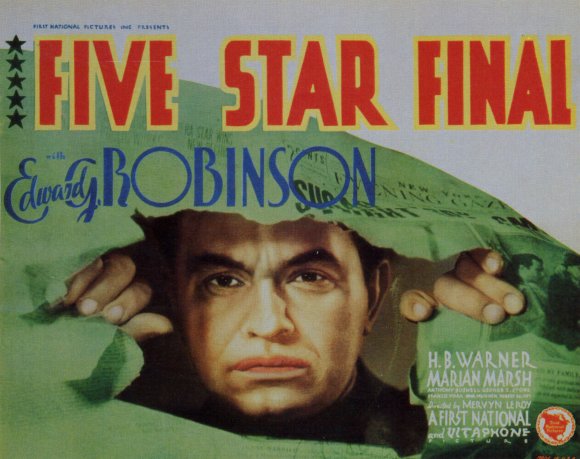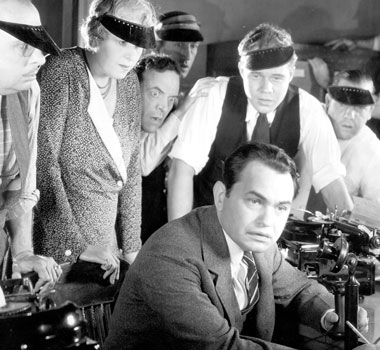In the early thirties, most studios steered clear of social protest films but not Warner Bros. They embraced the genre with the same muckraking glee that characterized some of their subjects. Prison reform was addressed in one of their most famous films, I Am a Fugitive from a Chain Gang (1932), with equally controversial topics like the rise in urban crime and drug addiction among war veterans being presented in The Public Enemy (1931) and Heroes for Sale (1933), respectively. Five Star Final (1931), on the other hand, addressed a different type of social problem – tabloid journalism.
This type of reportage pandered to a mostly uneducated readership with its exploitative mix of personal tragedies, prurient interest and rumors as facts, often destroying lives and careers in the process or stirring up volatile public reactions. And the “scandal sheet” identified as the Gazette in Five Star Final was typical of the sleazy newspapers that captured the public’s attention in the late twenties/early thirties. In fact, it was modeled on the notorious New York Evening Graphic, which was owned by Bernarr MacFadden (“The Father of Physical Culture”) with Louis Weitzenkorn serving as the managing editor. Who better than Weitzenkorn to write a “fictionalized” expose of his former racket as a stage play entitled Late Night Final? It became the source for Five Star Final and one of Warner Bros.’s most important releases of 1931; it even garnered an Oscar® nomination for Best Picture. (It is currently available on DVD from the Warner Archive Collection).
The film wastes no time in establishing the opportunistic nature of the tabloid press from the outset. Managing editor Joseph Randall (Edward G. Robinson) is ordered by Gazette owner Bernard Hinchecliffe (Oscar Apfel) to run a series of articles on the Voorhees case. Twenty years earlier Nancy Voorhees was demonized in newspapers for murdering her unfaithful fiancé after she became pregnant. Now she is happily married to Michael Townsend (H.B. Warner) and planning her daughter’s wedding to Phillip Weeks (Anthony Bushell). But the resulting Gazette news stories have a cataclysmic effect, prompting Nancy and her husband to take extreme measures after facing the headlines and driving their daughter Jenny (Marian Marsh) into a state of hysteria.
In his autobiography, All My Yesterdays, Edward G. Robinson recalled Five Star Final saying, “Consider this story in the light of those who today believe in the unabridged right of the press to print anything (and God knows I am among them). But Weitzenkorn posed a dilemma that has to be considered along with the First Amendment. Does freedom of the press not carry with it some freedom of compassion, some freedom concerning the rights of the innocently involved? Okay. The ethics are one problem: the character I played is another. I loved Randall because he wasn’t a gangster. I suspect he was conceived as an Anglo-Saxon. To look at me nobody would believe it, but I enjoyed doing him. He made sense, and thus I’m able to say that Five Star Final is one of my favorite films.”
It’s no surprise that Robinson would favor Five Star Final among his early films since the picture completely revolves around his character. And his first scene in the movie provides an important clue to his character; Randall is seen vigorously scrubbing his hands in the sink and it turns out it’s a common joke around the office. Whenever Randall is missing in action, his staff checks to see if he’s “washing up” in the bathroom. Does this sound like a man with a guilty conscience? In due time, Randall’s conflicted feelings over his editorial responsibilities are firmly resolved in the face of a tragedy he set in motion. Although the film rarely escapes its stage bound origins, it conveys an almost manic sense of urgency that seems completely right for its milieu. This was important to director Mervyn LeRoy who wrote in his autobiography Starmaker, “One concern I had in Five Star Final was to make sure that the newspaper office was authentic. Members of our staff in New York had sketches made of the interiors of two newspaper offices so that our dimensions were exactly correct. We even duplicated the neon lighting in the ceilings by having exceptionally bright arc lights blazing down from the top of the studio sound stage. Eddie Robinson loved the part of the dishonest editor, Randall…I went down on the set day after day to watch him work. Eddie’s attack, his vigor, his electric energy, made you forget he was a small and ugly man. He was a towering figure in pictures – a great star.”
While Edward G. Robinson is clearly the star of Five Star Final, there are several supporting players who shine in roles that are little more than caricatures in the script. Aline MacMahon as Randall’s world-weary secretary is also a no-nonsense feminist whose comments on the Voorhees case are all too true: “I think you can always get people interested in the crucifixion of a woman.” She also has a directness with Randall that comes out in their wisecrack patter and lines like “If you want my opinion, take me to a speakeasy. I’m not working for you then.”
Other standouts are Frances Starr, a former New York stage actress, as the doomed Nancy Voorhees and Ona Munson (her claim to fame is playing Belle Watling in Gone With the Wind, 1939) as the shameless and opportunistic street reporter Kitty Carmody. Best of all is Boris Karloff as the obsequious T. Vernon Isopod (who came up with this name?), an expelled divinity student now posing as a clergyman in order to get inside information on the Voorhees case. Karloff credits co-star and friend George E. Stone with getting him hired for Five Star Final plus the fact that he had already impressed LeRoy with his performance that same year in The Mad Genius. In fact, Karloff made a total of 16 films in 1931 with the most famous one being Frankenstein (1931), the movie that truly launched his film career.
Seen today Five Star Final has the subtlety of a sledgehammer and the tone is often as shrill and overbearing as a carny hawking his star attraction. Yet it all seems perfectly in keeping with its sordid story and is often fascinating for its Pre-Code take on morality and ethics. Upon its release, The Motion Picture Herald proclaimed it “crackerjack entertainment” and Variety wrote that “this talker totes a sock and its finish wallop can’t be ducked.” No finer compliments could be bought and just in case you didn’t get the film’s message, it’s summed up for you graphically under “The End” credit – a discarded copy of the Gazette is swept along by a street cleaner into the muck of the gutter.
Five Star Final was unavailable on any format for several years but in July 2010 the Warner Brothers Archive Collection released the film on DVD in a remastered edition.
*This is a revised and expanded version of the original article that first appeared on the Turner Classic Movies website – tcm.com
Other links of interest:
http://www.hollywoodsgoldenage.com/moguls/mervyn-leroy.html












Oh, that Aline MacMahon. She sends me!
I’m sure you’ve seen her in HEAT LIGHTNING (1934), one of the borderline Pre-Code films and a rare starring role for her. She sizzles and does her on-screen sister (played by Ann Dvorak).